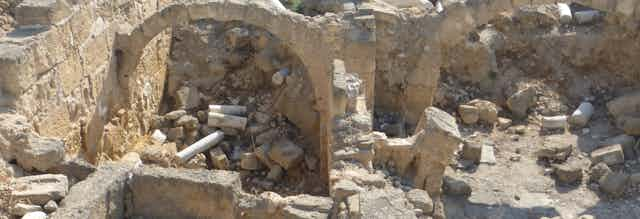Earthquakes were a cause of devastation in medieval Europe. The 1117 earthquake in northern Italy hit what was possibly the most densely populated area in Europe at the time. An earthquake in 1456 in southern Italy caused total or almost complete destruction over an area of about 6000km² and claimed around 30,000 lives.
In some cases, they triggered devastating environmental effects such as tsunamis – for example, in the eastern Mediterranean in 1303 — or massive landslides, such as the rockfalls induced by the Alpine earthquake of 1348.
From time to time, earthquakes also affected regions which we commonly (and wrongly) consider to be free of seismic activity. In 1382, cities in Flanders, France and England were affected by an earthquake – Canterbury suffered extensive damage. The shockwaves were felt in Leicester, London and Norwich.

Natural disasters were often seen through a religious lens – as an act of God. This was not the only thinking on the subject, though. One explanation for the cause of earthquakes, based on the thinking of the Greek philosopher Aristotle, was that they were caused by subterranean winds. Other explanations pinned the cause to astrology, or, less frequently, mythical underground creatures such as fish or dragons.
Medieval Europeans may not have known what we do now about why earthquakes occur. However, my research with Chris Gerrard and others at Durham University shows that medieval societies in Europe developed complex responses to seismic disasters. Communities affected by seismic activity were able to put strategies in place that often resemble modern risk management, organised around relief, rehabilitation, reconstruction and forward planning.
Immediate responses
The first stage in response to a seismic disaster – relief – included religious responses such as communal processions, votive masses, and in some cases the search for scapegoats to blame. However, pragmatic responses such as the search for survivors and the rescue of victims, the delivery of medical aid and food supplies were also widely adopted.

For instance, when a destructive earthquake struck the Greek island of Kos in 1493, the Christian military order of the Knights Hospitallers, organised a spectacular rescue operation. They sent a fleet from the islands of Leros and Kalimnos to transport doctors and surgeons from the order to the island along with a significant provision of medicine and timber for temporary shelters. They also delivered tools to grind flour to counteract the lack of essential foodstuffs during the initial emergency phase.
In the next stage – rehabilitation – one of the most urgent countermeasures was temporary housing for the displaced population. These seismic encampments were usually composed of tents and wooden barracks, and were located either outside permanent settlements or in large open spaces. They were occupied for months, or even years, in order to reduce the risk of injury from structural collapse. Medieval communities were well aware of the risk aftershocks could pose to already weakened buildings.
Rehabilitation was also sought through economic support in the form of tax exemption or fiscal relief. After a devastating earthquake and tsunami hit Crete in 1303, the Venetians supported the local production of bread by exempting bakers from taxes for a year (Crete was part of Venice’s maritime empire at the time).
Rebuilding
The reconstruction stage of earthquake response covers all those long-term actions which aim to return an area to normality after severe devastation. Medieval institutions often ordered preliminary surveys in order to list the damage caused by the earthquake. The reconstruction works were carried out on the basis of the reports produced.

Listen to Recovery, a series from The Anthill Podcast, to hear more about how the world recovered from past crises, including an episode on the aftermath of the 1755 Lisbon earthquake.
For instance, soon after the 1303 earthquake in Crete, Venetian magistrates were sent to the island to survey the damage. Not surprisingly, strategic infrastructures such as city walls, fortifications, public palaces and bridges but also churches were at the top of the list.
In a few cases, reconstruction involved the abandonment of an urban area and the creation of completely new towns. The two earliest new towns built as a result of planned post-seismic abandonment in Europe are Olot (1428) and Vera la Nueva (1518), both in Spain.

Another example, at which our team has conducted archaeological investigations, comes from the Azores, Portugal. In 1522 a massive landslide caused by an earthquake swept away the capital city of the recently colonised archipelago, Vila Franca do Campo. The new town was founded immediately west of the landslide.
Planning ahead
Medieval architects and builders were aware of the risk of future seismic events. Reconstruction works were also aimed at improving the seismic resilience of the repaired or newly built constructions. Several examples from medieval Spain, Italy, Greece and Cyprus show the adoption of earthquake-resistant techniques in the form of robust or exaggerated buttresses, reinforced walls and high-quality mortar.

From about the 14th and 15th centuries, interlocking timber frames with iron wall-ties – also known as anchor plates – were used in post-earthquake reconstruction in Italy. A few decades later, Leonardo da Vinci praised this technique as effective in resisting the shocks caused by earthquakes.
Interestingly, many wall-ties from Renaissance buildings constructed at L’Aquila in the aftermath of the 1461 earthquake are in the shape of a lily – the symbol of the Virgin Mary. Clearly, for many late medieval individuals, a combination of technological and devotional components was considered necessary to provide effective protection from the risk of earthquakes.

